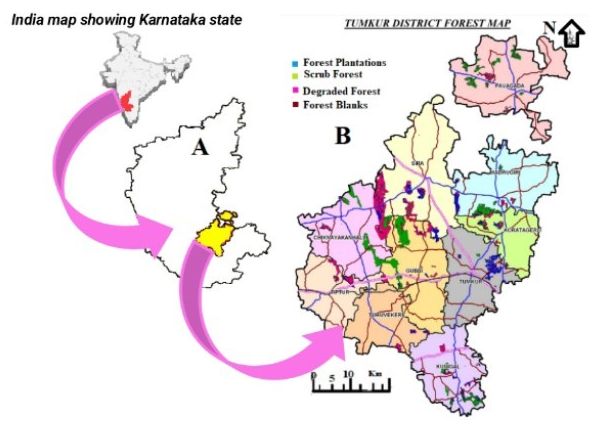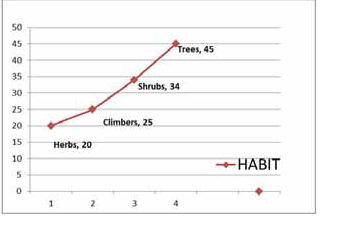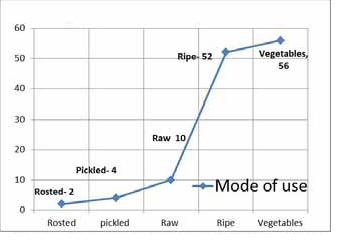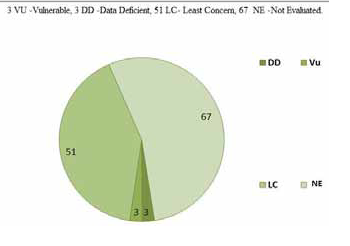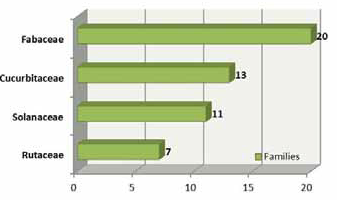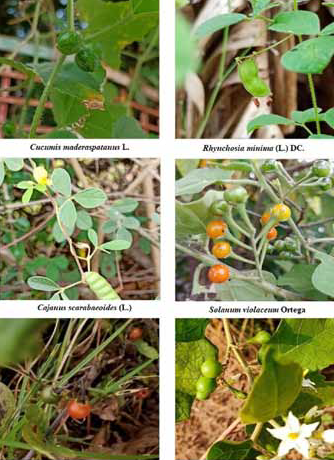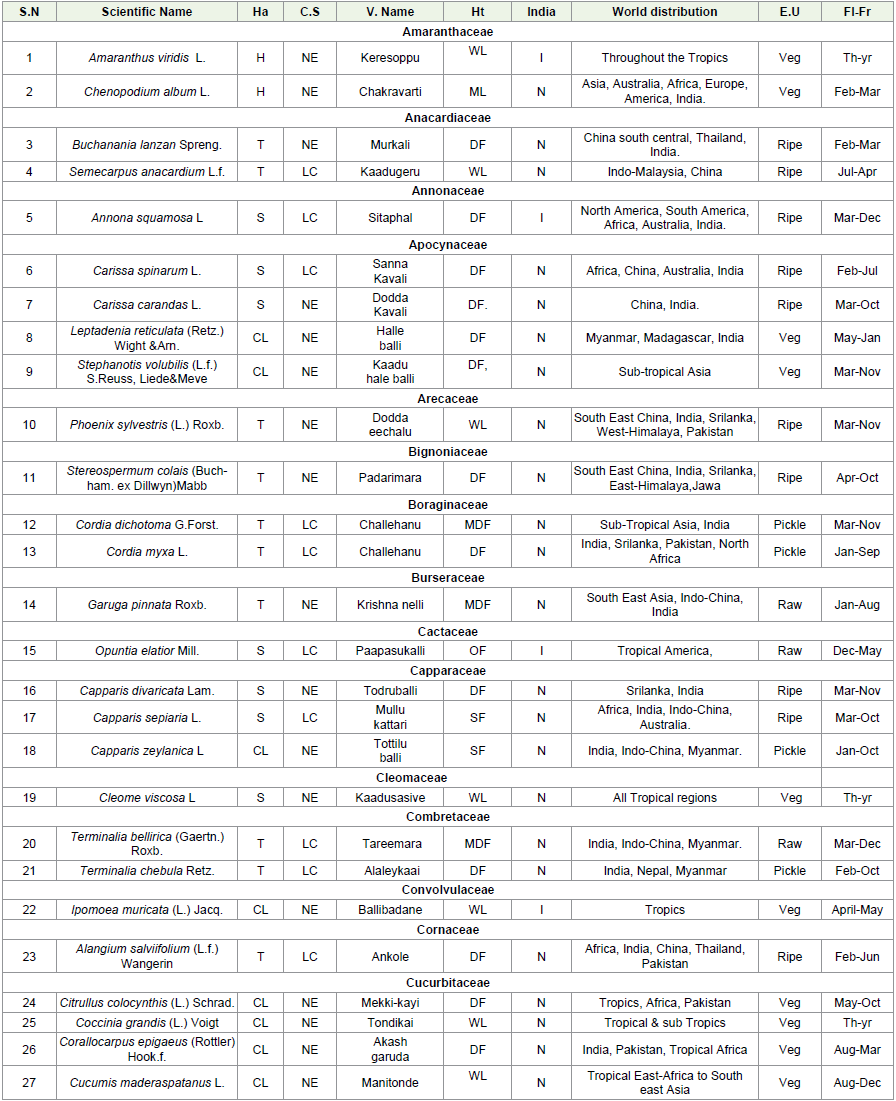Research Article
Checklist on Wild Edible Fruits from Forest Areas of Tumkur District, Karnataka, India
Nagashree G*and Kotresha K
Taxonomic and Floristic Division, Department of UG, PG and Research in Botany, Karnataka University, Dharwad, Karnataka, India
*Corresponding author:Nagashree. G, Taxonomic and Floristic Division, Department of UG, PG and Research in Botany, Karnataka University’s Dharwad, Karnataka, India. E-mail Id: poorvika123@gmail.com
Copyright:© Nagashree G, et al. 2024. This is an open-access article distributed under the Creative Commons Attribution License, which permits unrestricted use, distribution, and reproduction in any medium, provided the original work is properly cited.
Article Information:Submission: 22/12/2023; Accepted: 24/01/2024; Published: 30/01/2024
Abstract
This present study conducts a survey on enlisting of wild edible fruits species of Tumakuru district during the year 2020-2023. The data was collected by field visit. A total of 124 wild edible fruit species belonging to 46 families and 89 genera was reported. It focuses on diversity with its uses and knowledge of utilizing indigenous seasonal wild food source providing nutritional supplement. Due to the habitat destruction most of wild species of this area are disappearing and should be conserved for future generation. The study provides information on scientific name, families, habit, habitat, vernacular name, distribution, phenology, conservation status, ethno botanical uses and nativity.
Keywords:Conservation; Ethno botanical; Endangered; Nutritional supplement; Wild Edible Fruits
Introduction
Tumakuru is one of the religious place and third largest district
by area in Karnataka. It lies between north latitudes 13° 20’ 28.90”
N. and east longitudes 77° 06’ 7.92” E. The total geographic area in
the district is 10597 sq. km. and the forest area of district is 1292.76
sq. km which contributes hardly 12% of the total geographic area.
The forest varies from dry mixed deciduous to thorny scrub type. The
study area has several tribal communities, culture and traditions.
Reserve forest of Siddarabetta in Koratagere, Devarayanadurga
in Tumkurtaluk a, Bukkapatna in Sira, Thirtharampura in
Chikkanayakanahalli, Chowdlapura in Tiptur are major. Many forest
blocks and hills are also known to have varied type of microclimatic
zones and topographical features; it supports the growth of many types
of valuable flora from the foothills to the peak comprising different
flora. There is a threat on valuable flora due to over exploitation
leading the species to the verge of extinction [1].
Many literature works on wild edible fruits and traditional
knowledge on tribal communities conducted in world [2,3] and
India was reviewed [4-14]. From Karnataka state the wild edible
plants of Old Mysore district [15]. North Karnataka [16], Hyderabad-
Karnataka [17], Mali Madashwara hills, Southern India [18],
Angadihalli Hassan district [19], Ballari [20], Yadahalli of Bagalkot [21], Bhadravathitaluk, Karnataka [22], and Bidar [23] was reported, but the research work on wild edible fruits was not reported from
Tumakuru district. A study was made to checklist the wild edible
fruits especially near forest area of Tumakuru district.
Materials and Method
Study area:: Tumakuru district lies in the foot hills
Devarayanadurga, and located in southwestern part of Karnataka
state. It belongs to maidan group; the forest vegetation type is
southern tropical thorn forest series. The average annual rain fall
is 900 mm. The approximate elevation is 2697 ft. above the msl. It
has 10 taluks with 2715 villages [Figure 1]. The north western forest
blocks like Bukkaptana, Chikkanayakanahalli, Gubbi, Koratagere,
Sira, Madhugri, Pavagada and Tumakuru range have relatively better
diversity of species.The south eastern portion of forest blocks like
Tiptur, Turvekere, Kunigal has poor forest with scrubby and thorny
vegetation with bare boulders. The hill ranges of Devarayanadurga
and Siddarabetta of Tumakuru district are well known Hills, and also
the district has several religious Hillocks, with rich plant diversity
[24].
Data collection:
The data presented here is the outcome of 3 years from 2020-2023.
During this period many field surveys were undertaken in forest areas
Tumakuru district. The information collected directly from personal
observation. Wild edible fruits with their dietary uses were gathered
through interview and discussion. The gathered information was
entered in questionnaire prepared according to the methodology
adapted as per standard procedure [25].The herbarium was prepared for collected plant specimens;
identification was done with the help of recent and relevant floras
[26-28]. The names of identified plants and conservation states were
updated [29,30]. Herbariums were deposited in the department of
botany, Karnataka science college, Dharwad.
Result and Discussion
The present study enlisted total 124 wild edible fruit species from
forest areas of Tumakuru district belonging to 46 families and 89
genera. Based on habit 45 species were trees, 34 species were shrubs,
25 species were climbers and 20 species were herbs. It was observed
that maximum fruits (56%) used as vegetables. 52% consumed as
ripe, 10% species are edible as raw, 4% of fruits were pickled and 2%
fruits were roasted.
Out of 124 wild edible fruits 104 were native to India and 20
species were introduced to India. According to IUCN conservation
status 3 species were VU (Vulnerable), 3 species were DD (Data
Deficient), 51 species were LC (Least Concern), 67 species were NE
(Not Evaluated). The ripe fruits were used for preparation of juice;
raw fruits were used for preparation of pickle or cooked as vegetables.
All the documented species are list below in [Table 1] .
Plants flowers and fruits at particular season due to many factors
like drought, deforestation and over exploitation the plants are facing
the risk of extinction. Investigating local people in study area due to
over exploitation most of species like Buchanania lanzan, Flacourtia
indica, Garuga pinnata, Careya arborea, Ximenia americana, Carissa
carandas, has become limited. The studies also noticed that wild
relatives are having resistance gene for diseases and drought tolerance
in Fabaceae, (Cajanus scarabaeoides, Rhynchosia minima) Solanaceae
(Solanum incanum) and Cucurbitaceae (Cucumis trigonus) showing
significance decrease in their availability due to over grazing and [Figures 2-5]
deforestation. The study area is dry and deciduous; due to drought
wild plants are facing threat. Immediate measures in agro forestry
and social forestry is required also further encouraging farmers in
cultivating wild plants may decrease overexploitation.
Conclusion
The present study revels the evidence in utilization of wild edible
fruits and unstated local knowledge and its diversity. It explores indepth
wild resources used as alternate to crop plants. Under this
background the traditional knowledge has capability of identifying
wild resources of plants in the study area.
The climatic conditions of Tumakuru district provide a natural
environment and anthropogenic factors for the adaptation and
growth of plants in severe stress. They show many variations in
morphological features for further investigation of wild type.
The naturally grown wild plants form important source for crop
improvement, therefore there is need of conservation of germplasm
of wild edible fruit plants which are valuable resources required for
future, if neglected would be lost forever.
The traditional knowledge on wild edible fruit plants should
be known to future generation but it is getting eroded, the present
generation is lacking interest in such practices and are depleting
very fast due to urbanization and modern food practices. Therefore,
documentation of such precious knowledge on wild edible fruits
should be conserved for sustainable use.
Note: H-Herbs, T-Trees, S-Shrubs, CL-Climbers, I-Introduced,
N-Native, Ha-Habit, C.S-Conservation Status, ML-Moist Land, DFDeciduous
Forest, CF-Cultivated Land, SF-Scrub Forest, WL-Waste
Land, MDF- Moist Deciduous Forest, OF-Open Field, Pd-Pond,
SEF-Semi Evergreen Forest, EF-Evergreen Forest, NE-Not Evaluated,
DD-Data Deficient, LC-Least Concern, Vu-Vulnerable, Ht-Habitat,
EU-Edible Uses, Fl-Fr- Flowering and Fruiting, Th.Yr-Throughout
the year, Veg- Vegetable.
Acknowledgment:
The authors are expressing gratitude to the authorities of forest
officers of Tumakuru district for providing support and facilities
for the present work, also the respondents of Tumakuru district
for sharing the valuable information during the field visit. The
basic support and facilities were provided from Karnataka College,
Dharwad and Karnatak University, Dharawad
